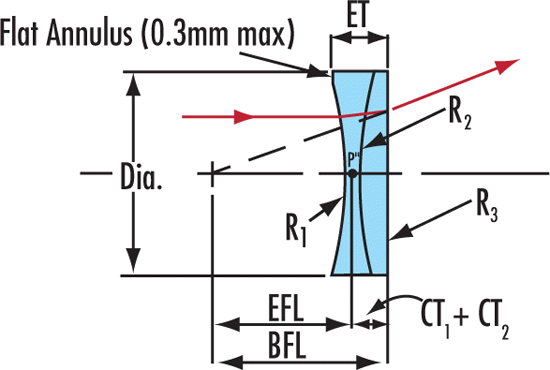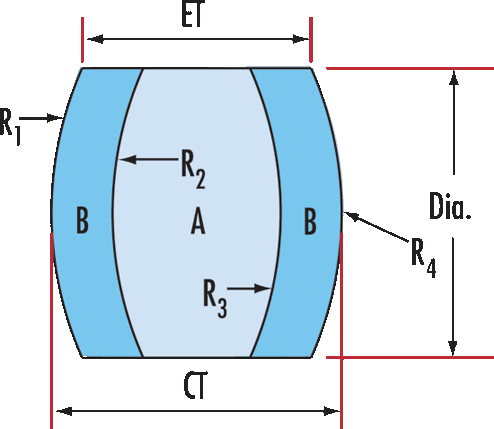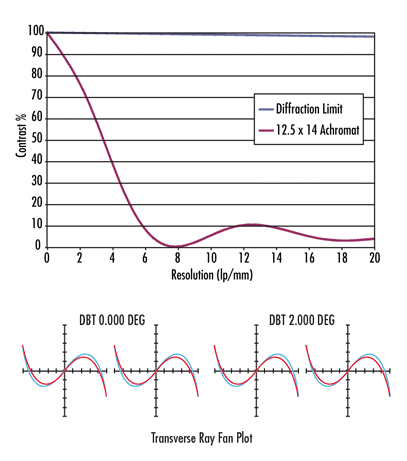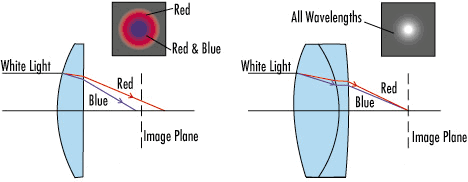Why Use an Achromatic Lens?
Anatomy of an Achromatic Lens
An achromatic lens, also referred to as an achromat, typically consists of two optical components cemented together, usually a positive low-index (crown) element and a negative high-index (flint) element. In comparison to a singlet lens, or singlet for short, which only consists of a single piece of glass, the additional design freedom provided by using a doublet design allows for further optimization of performance. Therefore, an achromatic lens will have noticeable advantages over a comparable diameter and focal length singlet.
An achromatic lens comes in a variety of configurations, most notably, positive, negative, triplet, and aspherized. It is important to note that it can be a doublet (two elements) or triplet (three elements); the number of elements is not related to the number of rays for which it corrects. In other words, an achromatic lens designed for visible wavelengths corrects for red and blue, independent of it being a doublet or triplet configuration. Refer to Figures 1 — 4 for illustrations of each type.

Figure 1: Positive Achromatic Lens

Figure 2: Negative Achromatic Lens

Figure 3: Triplet Lens

Figure 4: Aspherized Achromatic Lens
| Legend | |
|---|---|
| Dia. | Diameter |
| R | Radius of Curvature |
| ET | Edge Thickness |
| EFL | Effective Focal Length |
| CT | Center Thickness |
| P | Principle Point |
| BFL | Back Focal Length |
Exploring an Aspherized Achromatic Lens
A new technology linking the superior image quality of an aspheric lens with the precision color correction in an achromatic lens is here. An aspherized achromatic lenses is cost-effective featuring excellent correction for both chromatic and spherical aberrations, creating an economical way to meet the stringent imaging demands of today's optical and visual systems. Relays, condensing systems, high numerical aperture imaging systems, and laser beam expanders are a few examples of lens designs that could improve with the aid of an aspherized achromatic lens. Figures 5 and 6 compare an achromatic lens to an aspherized achromatic lens. Figure 5 shows a modulation transfer function (MTF) and transverse ray fan aberration plot for #45-209 12.5mm Diameter 14mm Focal Length TECHSPEC® Achromatic Lens, whereas Figure 6 shows the same for #49-658 12.5mm Diameter 14mm Focal Length TECHSPEC® Aspherized Achromatic Lens. It is easy to see that resolution performance is much better in the aspherized achromatic design.

Figure 5: MTF and Transverse Ray Fan Aberration Plots for Achromatic Lens

Figure 6: MTF and Transverse Ray Fan Aberration Plots for Aspherized Achromatic Lens
An aspherized achromatic lens is composed of glass optical lens elements bonded with a photosensitive polymer. The polymer is applied only on one face of the doublet and is easy to replicate in a short amount of time while providing the flexibility associated with typical multi-element components. Unlike a glass element however, an aspherized achromatic lens has a smaller operating temperature range, -20°C to 80°C. This temperature range also limits the possibility of Anti-Reflection (AR) Coatings on the aspherized achromat surface. The aspherized achromatic lens material blocks Deep-UV (DUV) transmission, making it unsuitable for some applications. Though not scratch resistant, the lens is cost-effective and simple to replace. The benefits of the technology remain substantial. Figure 7 overviews the manufacturing process.
 Diamond Ground Aspheric Mold and Achromatic Lens |
 Photopolymer Injection |
 Achromatic Lens Compression and UV Curing |
 Finished Aspherized Achromatic Lens |
Figure 7: Aspherized Achromatic Lens Manufacturing
 Diamond Ground Aspheric Mold and Achromatic Lens |
 Photopolymer Injection |
 Achromatic Lens Compression and UV Curing |
 Finished Aspherized Achromatic Lens |
Figure 7: Aspherized Achromatic Lens Manufacturing
Notable Performance Features
Improved Polychromatic Imaging
An achromatic lens is far superior to a simple lens for multi-color "white light" imaging. The two elements composing an achromatic lens (literally, "a lens with no color") are paired together for their ability to correct the color separation inherent in glass. Having eliminated the problematic chromatic aberrations, an achromatic lens becomes the most cost-efficient means for good polychromatic illumination and imaging. Refer to Figure 8 for an illustration of this concept.

Figure 8: Polychromatic Imaging using a Plano-Convex Lens versus an Achromatic Lens
Correction of Spherical Aberration and On-Axis Coma
Freedom from spherical aberration and coma implies better on-axis performance at larger apertures. Unlike a simple lens, an achromatic lens provides consistently smaller spot sizes and superior images without decreasing the clear aperture. Figure 9 shows how an achromatic lens corrects for longitudinal color and spherical aberration for an axial object; Figure 10 a double-convex lens breaking up white light similar to a prism, blue rays focus closer than red; Figure 11 how a double-convex lens is spherically under-corrected. Spherical Aberration (SA) varies with f/# and is less for a small aperture.

Figure 9: Achromatic Lens |

Figure 10: Longitudinal Color |
 Figure 11: Spherical Aberration |

Figure 9: Achromatic Lens |

Figure 10: Longitudinal Color |
 Figure 11: Spherical Aberration |
Brighter Images and Better Energy Throughput
Because on-axis performance of an achromatic lens will not deteriorate with larger clear apertures, "stopping down" the optical system becomes unnecessary. "Stopping down" the aperture refers to reducing its size, for example via a pinhole or iris diaphragm, in order to improve overall performance. With the entire clear aperture utilized, an achromatic lens and achromatic lens systems are faster, more efficient, and more powerful than equivalent systems using singlet lenses.


























or view regional numbers
QUOTE TOOL
enter stock numbers to begin
Copyright 2023, Edmund Optics Inc., 101 East Gloucester Pike, Barrington, NJ 08007-1380 USA
California Consumer Privacy Acts (CCPA): Do Not Sell or Share My Personal Information
California Transparency in Supply Chains Act